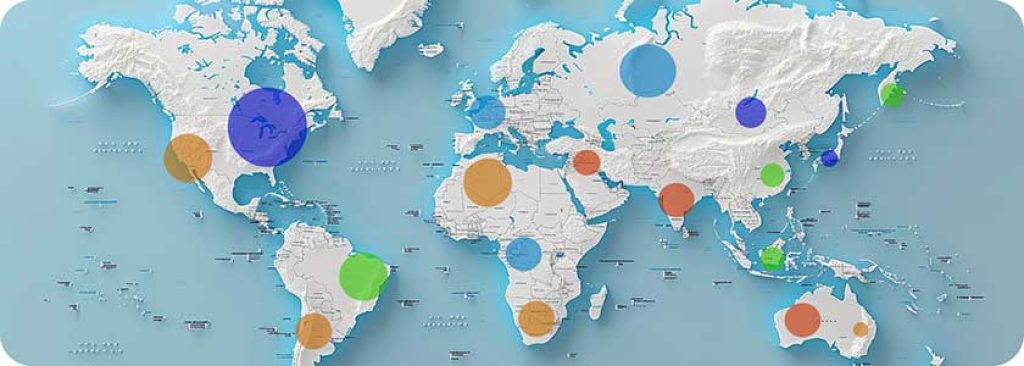VPAT Accessibility & Compliance
How VPAT & ACR Reporting Bring Accessibility Transparency
Before we get started explaining the hows, whys and wherefores, let’s clarify two terms up front:
The VPAT: What Is It?
The Voluntary Product Accessibility Template is a blank document with a structured format where digital tech producers and suppliers can detail the current conformance status of their products and services. While this template is just that, a blank template, for some reason many people will still refer to the completed VPAT as a VPAT.
ACR: What’s That?
The Accessibility Conformance Report is the report that results from a filled-out and completed VPAT. A completed VPAT should be called an ACR, but it often isn’t. One of those quirks of language. People prefer saying VPAT.
One more clarification: if an organization provides a VPAT or ACR, it doesn’t mean their products or services fully meet official and legal accessibility standards, or that they offer practical accessibility usage. It means the organization has provided a report on how well their tech meets the standards: the current extent of their compliance. It can mean that their accessibility status has been reviewed, and sometimes updated or fixed. Not always.
Web Accessibility and the WCAG
Web accessibility refers to the design and development of websites, web applications, and other digital content to be usable by everyone, with the specific intention of opening up the web and digital environments to people with disabilities. The World Wide Web Consortium (W3C)’s Web Accessibility Initiative (WAI) develops the Web Content Accessibility Guidelines (WCAG), which are the internationally recognized standards for web accessibility. Many countries, including the United States, use WCAG as a foundation for their accessibility laws. In Europe and the EU’s member states, the EN 301 549 standards and European Accessibility Act (EAA) are aligned with WCAG.
In the United States, two key laws mandate accessibility in specific contexts: Section 508 of the Rehabilitation Act and the Americans with Disabilities Act (ADA). Section 508 applies to the federal government and its web and tech suppliers, and requires all federal electronic and information technology to be accessible to people with disabilities. The ADA, a broader civil rights law, applies to both public and private entities.

Why Web Accessibility Matters for Public Service & Government Bodies
For government agencies and public service organizations, providing accessible digital content is a critical aspect of equal access to information and services. For these types of agencies and organizations, accessibility is a fundamental aspect of inclusive and equitable service delivery. Failure to provide accessible content not only violates legal obligations, it risks excluding significant portions of the population from participating fully in society. This includes accessing vital services, information, and opportunities for civic engagement. With approximately 75% of United States citizens with disabilities using the internet on a daily basis, and with government-related interactions offered online more than ever, it’s safe to say web accessibility is important for a large swathe of the American public.

The Voluntary Product Accessibility Template (VPAT)
A Voluntary Product Accessibility Template (VPAT) is a standardized document that outlines how an information and communication technology (ICT) product conforms to specific accessibility criteria. These criteria are invariably based on the WCAG’s internationally recognized standards.
Developed by the Information Technology Industry Council (ITI), the VPAT is designed to assist federal contracting officials and other buyers in making preliminary assessments regarding the availability of commercial Electronic and Information Technology products and services with features that support accessibility.
The VPAT is a starting point. It provides a structured format for organizations to disclose how accessible their products are, or aren’t. Organizations can then build upon this template to create a full accessibility report that details specific features and functionalities related to accessibility. The resulting report is generally known as an ACR (Accessibility Conformance Report). However, many refer to the final report under the name of its template: VPAT.
VPATs play a valuable role in promoting accessibility by increasing transparency. They serve as a self-disclosure mechanism for vendors to document their product's conformance with recognized accessibility standards, providing a baseline for comparison and improvement. And, they are an excellent way for organizations to clearly communicate their efforts towards making their products accessible to people with disabilities. This transparency:
For large organizations, government agencies, and their suppliers, public visibility of their efforts towards accessibility demonstrates a commitment to inclusivity and legal compliance. Even if a VPAT reveals that a product is not fully accessible, transparency remains important. It offers users with disabilities the option to make informed choices and encourages ongoing progress towards accessibility goals. VPATs also encourage:
The VPAT and resulting ACR highlight an organization's commitment to accessibility, providing a clear, transparent framework for evaluating and communicating a product's ability to meet diverse user needs. This openness supports legal and ethical obligations and cultivates a more inclusive digital landscape at critical societal points.

The VPAT’s Contribution To Digital Inclusivity
The Voluntary Product Accessibility Template (VPAT) acts as a framework for evaluating and documenting a technology product's accessibility features against established standards. By using VPATs to create accessibility transparency reports (ACRs), organizations can show whether and how their digital content, products, and services are accessible, revealing barriers that people with disabilities might face in a public way that encourages the organization to eliminate accessibility obstacles with a set deadline. This proactive approach towards inclusivity improves user experience for a diverse audience and aligns with global efforts to fully integrate digital accessibility.
Advantages Of ACR & VPAT Reporting
VPATs offer several benefits for the organizations and businesses that are required to produce them:
- Reduced Legal Risk
VPATs can help demonstrate a company's good faith effort towards accessibility, potentially mitigating legal risks associated with accessibility lawsuits. - Brand Image Boost
By prioritizing accessibility, business enterprises and organizations such as universities can project a positive brand image that is socially responsible and inclusive. - Expanded Market Reach
Accessible products reach a wider audience, including the significant market segment of people with disabilities. For manufacturers and distributors of digital products and services, this is a notable advantage.
Achieving Accessibility With VPAT Certification
Achieving VPAT-oriented compliance and providing full VPAT certification is essential for organizations committed to inclusivity and accessibility in their digital products, as well as those wishing to maintain legal conformance in both their actual accessibility criteria and their reporting status. Here’s a structured approach:
The first step is to conduct a thorough accessibility audit of your products and services.
This audit should identify areas where your offering falls short of VPAT criteria based on WCAG and any other relevant standards.
Several automated and manual testing tools can assist with this process.
Identify the gaps: find all discrepancies between your current product accessibility and the VPAT standards.
Then, prioritize adjustments: Based on audit findings, sort the changes needed.
Focus on modifications that will have the most significant impact on usability for people with disabilities.
Once accessibility gaps are identified, develop a plan to implement necessary design, content or coding changes to meet or exceed VPAT standards.
This may involve modifying code, redesigning elements for better navigation, adding alternative text descriptions for images, or improving keyboard navigation functionalities
Although no official credentials are required to write up these reports, common sense should tell you that these complicated testing and reporting procedures are not something most people can or should complete on their own.For accessibility audits and VPATs, always consult accredited professionals. Don’t try to do it yourself unless you’re an expert.
Incorporate accessibility considerations throughout the development lifecycle. Address new accessibility requirements as standards evolve.
Educate your team: Train them in the principles and practices of accessible design and development so new content is compliant from the outset.Regular reviews and updates are essential to maintain VPAT compliance.
Remember: Establish a schedule for regular accessibility reviews of your product. Technology and standards evolve, so continuous assessment is vital to remain compliant. Update VPAT documentation with any changes or improvements made to the product. Transparency in your progress and current compliance status is critical for users and stakeholders. And, involve users with disabilities in testing and feedback loops. Their insights and on-the-spot testing can guide improvements so your product remains accessible and user-friendly.

5 Top Tips for VPAT Compliance
Achieving and maintaining VPAT compliance can present challenges for companies. Some common obstacles can include resource limitations and rapidly evolving standards. Accessibility expertise can be scarce, and implementing accessibility features may require additional time and development resources. Small to medium-sized organizations, in particular, may find it difficult to allocate the necessary resources for comprehensive accessibility audits and the implementation of required changes. And, accessibility standards like the WCAG and the laws that use it as a foundation are updated periodically, meaning companies need to stay informed and follow their guidelines and best practices to remain compliant, as well as adapting all products and services to meet the latest requirements.
To help your organization overcome these roadblocks:
- Prioritize Accessibility Awareness
Integrate accessibility training into the development and design processes. Equip your team with the knowledge and skills needed to understand and implement accessibility standards. Regular training sessions can help keep everyone up to date on the latest requirements and techniques for creating accessible content. - Seek Expert Guidance
Consider consulting with accessibility specialists who can provide in-depth expertise and support complex projects. While seeking guidance from professionals can and should be a part of working towards a VPAT report, it’s also an overall essential. - Leverage Automated Testing Tools
Utilize automated accessibility testing tools to streamline the accessibility testing process and identify potential accessibility issues early in development. While automated tools should not be the sole method of evaluation, they can significantly streamline the audit process. These tools can quickly identify some common accessibility issues, allowing your team to focus on more complex aspects of compliance that require manual review. - Maintain Accessibility Documentation
Accessibility is an ongoing commitment. Plan for regular reviews of your products and services to ensure they remain compliant with current standards. Maintain clear and up-to-date accessibility documentation to track progress, identify trends, and facilitate ongoing compliance efforts. - Promote Accessibility Culture
Foster a company culture that values accessibility and encourages continuous improvement in accessible product development. Cultivating an organizational culture that values accessibility and inclusivity can help accessibility considerations become a standard part of the process, rather than an afterthought. Requesting input from users with disabilities can also provide valuable insights into how your products can be improved.
Going Global: VPAT Accessibility
The Voluntary Product Accessibility Template (VPAT) plays a crucial role in promoting accessibility not just within the United States but around the globe. As the focus on digital inclusion intensifies worldwide, the VPAT serves as a versatile tool that aligns with international efforts, offering a standardized framework for communicating accessibility features across borders. Adaptable for various standards including the European EN 301 549, VPAT reporting allows organizations to document their products' accessibility in a way that's recognized and respected globally.
VPAT compliance can also be a valuable asset for organizations seeking to enter international markets. By demonstrating a commitment to accessibility through VPAT documentation, organizations can:
- Meet Local Regulations: Many countries have established their own digital accessibility laws and standards, often inspired by or directly aligned with WCAG. VPAT compliance can help companies meet these diverse regulatory requirements, simplifying the process of entering new markets.
- Build Trust with Global Customers: Accessibility is a universal concern. Companies that prioritize and transparently report their efforts in making products accessible are more likely to gain the trust of a global customer base.
- Stand Out in Competitive Markets: In many industries, demonstrating a commitment to accessibility can differentiate a company from its competitors. VPAT compliance signals to international partners and customers that a company is legally compliant and socially responsible, opening doors to new business opportunities.
With reports showing proof of their conformance to accessibility standards, companies can confirm their products meet diverse accessibility requirements, potentially streamlining market entry and reaching a wider global audience.
In an era where digital platforms are integral to daily life, web accessibility transcends compliance, helping direct the path of human society towards inclusivity and equality. Transparent reporting on the status of accessibility is more than a regulatory requirement, it’s a fundamental component of this mission. The VPAT and ACR reports alert users with disabilities to potential accessibility blockers while holding organizations accountable. Through collective efforts to improve both accessibility and our openness about the journey there, we move closer to a world where digital spaces are truly accessible, where everyone, regardless of abilities, can fully participate in our interconnected society.

FAQs
Any organization that develops or sells information and communication technology (ICT) products can benefit from creating a VPAT. This includes software companies, hardware manufacturers, and vendors of electronic content.
That depends on whether the company provides any services or products to the U.S. federal government in any capacity, even one step removed. This covers more ground than may be immediately obvious. And, while VPAT compliance is not mandated by law for most private sector companies, it is certainly encouraged as a demonstration of commitment to accessibility. It can also aid in legal compliance with broader accessibility laws and standards.
A VPAT disclosing accessibility gaps is not a negative. It demonstrates transparency and allows for targeted improvements to advance accessibility in future product iterations.
A product not meeting all criteria should still be documented in the VPAT, which includes detailing the areas of partial or non-compliance. This transparency is crucial for users and procurement officials to make informed decisions and for organizations to plan for improvements.









